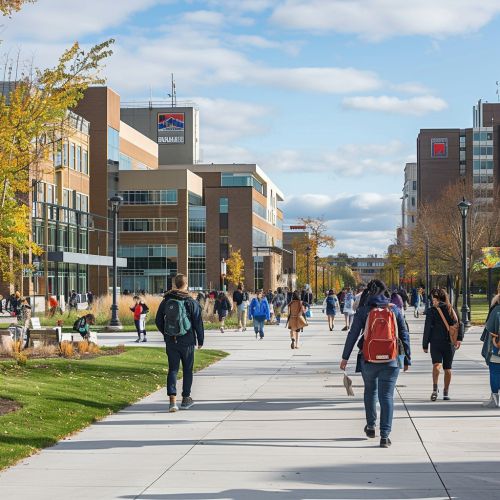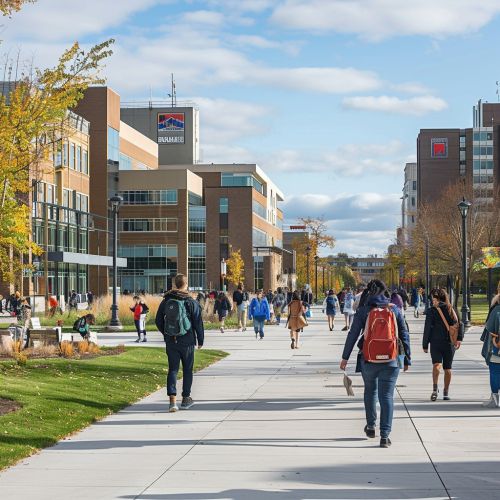University at Buffalo: Difference between revisions
(Created page with "== History == The University at Buffalo (UB), officially known as the State University of New York at Buffalo, is a public research university with campuses in Buffalo and Amherst, New York. It was founded in 1846 as a private medical college and merged with the State University of New York (SUNY) system in 1962. The university has grown significantly over the years, becoming one of the largest and most comprehensive institutions in the SUNY system. == Campuses == UB op...") |
No edit summary |
||
| Line 20: | Line 20: | ||
UB is classified as an R1: Doctoral Universities – Very high research activity by the Carnegie Classification of Institutions of Higher Education. The university conducts cutting-edge research in various fields, including biomedical sciences, engineering, and social sciences. It is home to several research centers and institutes, such as the New York State Center of Excellence in Bioinformatics & Life Sciences and the Institute for Lasers, Photonics and Biophotonics. | UB is classified as an R1: Doctoral Universities – Very high research activity by the Carnegie Classification of Institutions of Higher Education. The university conducts cutting-edge research in various fields, including biomedical sciences, engineering, and social sciences. It is home to several research centers and institutes, such as the New York State Center of Excellence in Bioinformatics & Life Sciences and the Institute for Lasers, Photonics and Biophotonics. | ||
[[Image:Detail-97085.jpg|thumb|center|University at Buffalo North Campus with students walking and buildings in the background.|class=only_on_mobile]] | |||
[[Image:Detail-97086.jpg|thumb|center|University at Buffalo North Campus with students walking and buildings in the background.|class=only_on_desktop]] | |||
== Student Life == | == Student Life == | ||
Latest revision as of 12:41, 19 July 2024
History
The University at Buffalo (UB), officially known as the State University of New York at Buffalo, is a public research university with campuses in Buffalo and Amherst, New York. It was founded in 1846 as a private medical college and merged with the State University of New York (SUNY) system in 1962. The university has grown significantly over the years, becoming one of the largest and most comprehensive institutions in the SUNY system.
Campuses
UB operates three campuses: the North Campus in Amherst, the South Campus in Buffalo, and the Downtown Campus in Buffalo.
North Campus
The North Campus, located in suburban Amherst, is the largest of the three campuses. It houses most of the university's academic departments, administrative offices, and student residences. Key facilities include the Capen Hall, the Student Union, and the Center for the Arts.
South Campus
The South Campus, located in a residential neighborhood in Buffalo, is the original site of the university. It is home to the School of Architecture and Planning, the School of Dental Medicine, and the School of Public Health and Health Professions. The campus features classic collegiate architecture and is listed on the National Register of Historic Places.
Downtown Campus
The Downtown Campus is the newest addition, focusing on medical and health sciences. It includes the Jacobs School of Medicine and Biomedical Sciences and is part of the Buffalo Niagara Medical Campus, a consortium of healthcare, research, and educational institutions.
Academics
UB offers a wide range of undergraduate, graduate, and professional programs. It is organized into 13 schools and colleges, including the College of Arts and Sciences, the School of Engineering and Applied Sciences, and the School of Management.
Research
UB is classified as an R1: Doctoral Universities – Very high research activity by the Carnegie Classification of Institutions of Higher Education. The university conducts cutting-edge research in various fields, including biomedical sciences, engineering, and social sciences. It is home to several research centers and institutes, such as the New York State Center of Excellence in Bioinformatics & Life Sciences and the Institute for Lasers, Photonics and Biophotonics.


Student Life
UB offers a vibrant student life with numerous student organizations, clubs, and activities. The university has over 300 student-run clubs and organizations, including academic, cultural, and recreational groups. The Student Association, the primary student government body, plays a significant role in organizing events and representing student interests.
Housing
The university provides various housing options, including traditional residence halls, apartment-style living, and specialized living-learning communities. The North Campus houses most of the undergraduate residences, while the South Campus offers housing primarily for graduate and professional students.
Athletics
UB's athletic teams, known as the Buffalo Bulls, compete in the NCAA Division I Mid-American Conference (MAC). The university offers a wide range of sports, including football, basketball, and soccer. The Alumni Arena and UB Stadium are the main athletic facilities on campus.
Notable Alumni
UB has a diverse and accomplished alumni network, with graduates excelling in various fields such as academia, business, politics, and the arts. Notable alumni include NASA astronaut Gregory Jarvis, Nobel Prize-winning chemist Herbert A. Hauptman, and former U.S. Secretary of Housing and Urban Development Henry Cisneros.
